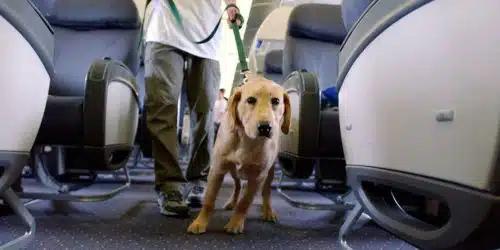If you have a pet like a dog and are planning on traveling with them. It requires thorough preparation and attention to their needs. Start by researching pet-friendly accommodations and travel options, and ensure you have all necessary travel documents and identification. You might as well visit the veterinarian for a health check-up and ensure your dog is up-to-date on vaccinations. Consider your dog’s temperament and whether they can handle travel. There are lots of things to consider and this post about how to travel with a dog gives a detailed guide on what you need to know.
How To Travel With A Dog
Traveling with a dog can be a rewarding experience, but it requires some planning and preparation to ensure the safety and comfort of your furry companion.
Here are some essential tips on how to travel with a dog:
#1. Visit the Vet
Before you travel, take your dog to the veterinarian for a check-up to ensure they are healthy and fit for travel. Make sure all vaccinations and necessary medications are up to date. Ask your vet for any specific advice related to your dog’s health during the journey.
#2. Identification and Microchipping
Ensure your dog has proper identification. Including a collar with an ID tag containing your contact information. Consider microchipping your dog, as it can increase the chances of being reunited in case they get lost during the trip.
#3. Travel Carrier or Crate
If you’re traveling by plane, train, or some other form of public transportation, check the specific regulations regarding pet carriers. Use a well-ventilated and secure carrier or crate that is appropriate for your dog’s size. To allow them to stand, turn around, and lie down comfortably.
#4. Car Travel Safety
If you’re traveling by car, use a dog seat belt or a travel crate to keep your dog secure and prevent them from roaming inside the vehicle. Never let your dog ride with their head out of the window, as it can be dangerous and lead to injuries.
#5. Pack Essentials for Your Dog
Bring your dog’s favorite toys, familiar bedding, and enough food and treats for the duration of the trip. Carry a leash, waste bags, and a portable water bowl for pit stops.
#6. Plan Frequent Breaks
If you’re driving long distances, plan regular breaks to allow your dog to stretch their legs. Or go for a walk, and relieve themselves. This is essential for their comfort and well-being.
#7. Pet-Friendly Accommodations
When booking accommodations, ensure that the places you’ll be staying allow pets. Many hotels, motels, and rental properties have specific pet-friendly rooms or areas.
#8. Research Pet Policies
If you plan to visit attractions or public places during your trip, research their pet policies beforehand. Some places may not allow dogs, while others may require dogs to be on a leash.
#9. Keep Them Hydrated
Make sure your dog has access to fresh water during the journey to stay hydrated, especially during hot weather.
#10. Avoid Leaving Your Dog Unattended
Never leave your dog unattended in a parked car, as temperatures can rise quickly, posing a severe risk of heatstroke.
#11. Practice Calm Behavior
During travel, stay calm and reassured to keep your dog at ease. Dogs can pick up on their owners’ emotions, so remaining calm will help them feel more comfortable.
#12. Check Travel Restrictions
If you’re traveling across borders or to a different country, research the specific travel requirements and restrictions for pets. Including vaccinations, quarantine rules, and necessary documentation.
How To Travel With A Dog On A Plane
Here’s a guide on how to travel with a dog on a plane:
#1. Check Airline Policies
Different airlines have specific rules and regulations regarding pet travel. Research and choose an airline that accommodates pets and review their pet travel policies thoroughly. Pay attention to size restrictions, carrier requirements, and any additional fees.
#2. Book Early
Airlines often have limited space for pets in the cabin. Some airlines have restrictions on the number of pets allowed on each flight, so early booking is essential.
#3. Select the Right Carrier
Make sure the carrier is well-ventilated, secure, and spacious enough for your dog to stand, turn around, and lie down comfortably. Soft-sided carriers are generally recommended for in-cabin travel.
#4. Get Your Dog Used to the Carrier
If your dog isn’t already familiar with the carrier, help them acclimate to it gradually before the trip. Place treats, toys, and bedding inside the carrier to create positive associations.
#5. Visit the Vet
Take your dog to the veterinarian for a pre-flight check-up. Make sure they are up to date on vaccinations and obtain a health certificate stating that your dog is fit to travel. Airlines often require health certificates issued within a specific time frame before the departure date.
#6. Avoid Sedation
It’s generally not recommended to sedate your dog for air travel. It can be risky due to changes in air pressure and temperature.
#7. Pack Essentials
Carry your dog’s essentials, including food, treats, a collapsible water bowl, a leash, and any medications they may need. It’s also a good idea to have some absorbent pads or liners in case of accidents.
#8. Arrive Early
Arrive at the airport early to allow enough time for check-in and to ensure a stress-free boarding process. Keep in mind that the check-in process with a pet may take longer than usual.
#9. Security Screening
When going through security, you’ll need to take your dog out of the carrier while the carrier is screened separately.
#10. Follow the Airline’s Guidelines
Follow the airline’s guidelines on when and how to take your dog out of the carrier during the flight.
#11. Stay Hydrated
Offer water to your dog during the flight, but avoid overfeeding to minimize the need for bathroom breaks.
How To Travel With A Dog Internationally
Traveling with a dog internationally requires extensive planning and compliance with various regulations and requirements. Both the destination country and the country of departure.
Here is a comprehensive guide on how to travel with a dog internationally:
#1. Check Pet Import Regulations
Research the specific pet import regulations of the country you’re traveling to. Each country has different requirements regarding vaccinations, health certificates, microchipping, and quarantine periods.
#2. Visit the Veterinarian
Take your dog to the veterinarian for a thorough check-up and to ensure they are healthy and fit for international travel. Your vet can provide the necessary vaccinations and issue a health certificate required for travel.
#3. Microchip Your Dog
Many countries require pets to be microchipped with an ISO 11784/11785 compliant 15-digit pet microchip. Ensure that the microchip is registered with your contact information and is readable by scanners used in the destination country.
#4. Vaccinations and Medications
Check the required vaccinations for your destination country. Some countries have specific vaccine requirements, like rabies vaccinations. Obtain the necessary vaccinations and make sure to carry the vaccination records with you.
#5. Get a Pet Passport
Some countries recognize a pet passport as a valid form of identification for traveling with pets. A pet passport includes your pet’s microchip information, vaccination history, and health certificate.
#6. Research Quarantine Rules
Find out if your destination country has any quarantine requirements for incoming pets. Some countries may require pets to undergo a quarantine period upon arrival.
#7. Choose the Right Airline
Look for airlines that are experienced in pet transportation and have specific procedures for international pet travel.
#8. International Pet Carrier
Ensure your pet carrier meets international travel standards for size, ventilation, and security.
#9. Book in Advance
Reserve your dog’s spot on the flight well in advance, as some airlines have limited space for pets in the cabin.
#10. Prepare Your Dog for Travel
Get your dog accustomed to the carrier, especially if they are not used to traveling. Gradually increase the time they spend inside it and provide positive reinforcement.
#11. Plan Layovers Carefully
Comply with the transit regulations of the countries where the layovers take place. If you have layovers during your journey.
#12. Health Check Before Return
Before returning to your home country, schedule a visit to a veterinarian in the destination country. To ensure your pet is healthy and meets the return travel requirements.
#13. Contact the Embassy or Consulate
If you have any questions or concerns about traveling with your dog to a specific country. Contact the embassy or consulate of that country for guidance and clarification on their pet import regulations.
Pros And Cons Of Traveling With a Dog
Traveling with a dog can be a wonderful and rewarding experience, but it also comes with certain challenges and considerations.
Here are some of the pros and cons of traveling with a dog:
Pros
#1. Companionship
Having your dog with you during your travels can provide companionship and emotional support, which can be especially comforting in unfamiliar places.
#2. Bonding Experience
Traveling with your dog can strengthen your bond and create lasting memories together.
#3. Exploring Pet-Friendly Places
Traveling with a dog allows you to explore pet-friendly destinations, parks, and outdoor activities that you may not have considered otherwise.
#4. Health Benefits
Dogs need exercise, so traveling with them encourages you to be more active and engage in outdoor activities.
#5. Security
Having a dog with you can provide an extra layer of security and peace of mind, especially when staying in new or unfamiliar places.
Dogs can be great conversation starters, helping you connect with locals and other pet owners while traveling.
#7. Less Separation Anxiety
If your dog experiences separation anxiety when you’re away, bringing them along can alleviate their stress and give you peace of mind.
Cons
#1. Travel Restrictions
Traveling with a dog can be challenging due to airline or transportation restrictions, pet fees, and limitations on pet-friendly accommodations.
#2. Planning and Preparation
Traveling with a dog requires extensive planning. Including researching pet policies, arranging pet-friendly accommodations, and ensuring compliance with health and vaccination requirements.
#3. Health and Safety Concerns
Dogs can experience stress and anxiety during travel, and some may not adapt well to new environments or long journeys.
#4. Unpredictable Behavior
While most dogs are well-behaved, some may exhibit unpredictable behavior in new or stressful situations. It can be challenging to manage during travel.
#5. Limited Activities
Some tourist attractions, restaurants, and public places may not allow dogs, restricting your options for activities and dining.
#6. Health Risks
Traveling may expose your dog to new environments, potentially leading to exposure to diseases or parasites.
#7. Cost
Traveling with a dog can be more expensive due to additional pet fees, and pet-friendly accommodations. Also, possible veterinary expenses in case of health issues.
How Do You Travel Long Distances with A Dog?
There are several tips for traveling long distances with a dog. Including getting them used to car journeys, and keeping them restrained during the ride. It also includes using a pet carrier, travel crate, or doggy car harness, and staying hydrated. Feeding them 3-4 hours before traveling, and ensuring that they have a valid health certificate if flying. It is also important to do your research and follow import/export restrictions.
Can Dogs Fly In Baggage?
Yes, some airlines allow dogs to fly in the baggage compartment as accompanied by checked baggage if the airline offers this service. However, it’s important to note that this can be stressful for the dog, and certain breeds such as brachycephalic (short-nosed) dogs may not be allowed to fly in the baggage compartment. It’s important to check with the specific airline for their pet policy and restrictions for flying with dogs in baggage.
What Dogs Need When Travelling?
When traveling, dogs need certain things. Such as good health, updated identification tags, a comfortable carrier or crate, food, water, treats, a bed or blanket, a leash, and medications (if needed). They may also require a health certificate or proof, depending on the mode of travel and destination. It’s important to check with the specific airline or mode of transportation for their pet policy and restrictions before traveling with your dog.
How Much Does It Cost To Bring A Dog On A Plane?
The cost of bringing a dog on a plane can vary depending on the airline and destination. On average, airlines charge a fee of around $100 to $125 one-way to bring a dog in the cabin. Some airlines may charge more for larger dogs or travel to international destinations. It is best to check with the specific airline for their pet policy and fee schedule before booking a flight with your dog.
What Size Is Allowed On The Plane?
The size of the dog allowed on the plane can vary depending on the airline. Most airlines have weight and size restrictions for in-cabin travel. The weight is usually capped at 20 pounds for dogs and the carrier size is restricted to fit under the seat. Some airlines may allow large dogs in the cabin if they can fit comfortably in an airline-approved carrier. Those that can fit under the seat in front of the passenger. It’s best to check with the specific airline for their pet policy and restrictions on size and weight before booking a flight with your dog.
Is It Stressful For Dogs To Fly?
Yes, flying can be stressful for dogs, especially when they are traveling in the cargo hold of a plane. Even for in-cabin travel, dogs may experience stress due to unfamiliar environments and noise. It’s important to make proper preparations and arrangements to minimize stress and ensure the safety and well-being of the dog during air travel.
What Dogs Are Not Allowed On Airplanes?
Some airlines have restrictions and bans on certain breeds of dogs for air travel, especially in the cargo hold. These restrictions may include brachycephalic (short-nosed) breeds like Pugs and Bulldogs. As well as breeds that are considered dangerous or aggressive. Such as American Pit Bull Terriers, American Staffordshire Terriers, and some Mastiff breeds. Some airlines may have restrictions on dogs under a certain age or size, or animals that have been sedated during travel. It’s important to check with the specific airline for their pet policy and restrictions on breed and size before booking a flight with your dog.
What Happens To Dogs When They Fly?
When dogs fly, the specific conditions and treatment can vary depending on various factors. Such as the airline, the size of the dog, and whether they are traveling in the cabin or cargo hold. In the cargo hold, dogs are kept in a secure and temperature-controlled area, with access to food and water if required. However, this can still be stressful for some dogs, especially those that are not used to traveling or being in a confined space. When traveling in the cabin, dogs are often required to be in an airline-approved carrier that can fit under the seat in front of the passenger. They must remain in the carrier throughout the flight. Some airlines may also require additional paperwork and documentation for dog travel.
Conclusion
Traveling with a dog involves careful planning and consideration to ensure their safety, comfort, and well-being. Some key aspects to keep in mind include researching pet-friendly accommodations, preparing necessary travel documents, ensuring proper identification and vaccination, providing suitable transportation, packing essential items for your dog, and being attentive to their needs throughout the journey.
When traveling with a dog, it is important to prepare by consulting with a veterinarian, updating identification tags, and packing essentials such as food, water, and a bed or crate. Plan stops for bathroom breaks and secures the dog in the car using a pet car seat, crate, or seat belt leash. Check airline requirements and research pet-friendly accommodations. Consider weather and activities, and follow local laws and regulations.
Related Articles
- BEST TRAVEL FIRST AID KIT OF 2023
- BEST DESTINATIONS FOR VACATION IN AFRICA
- POST-VACATION DEPRESSION: How To Cope With It






